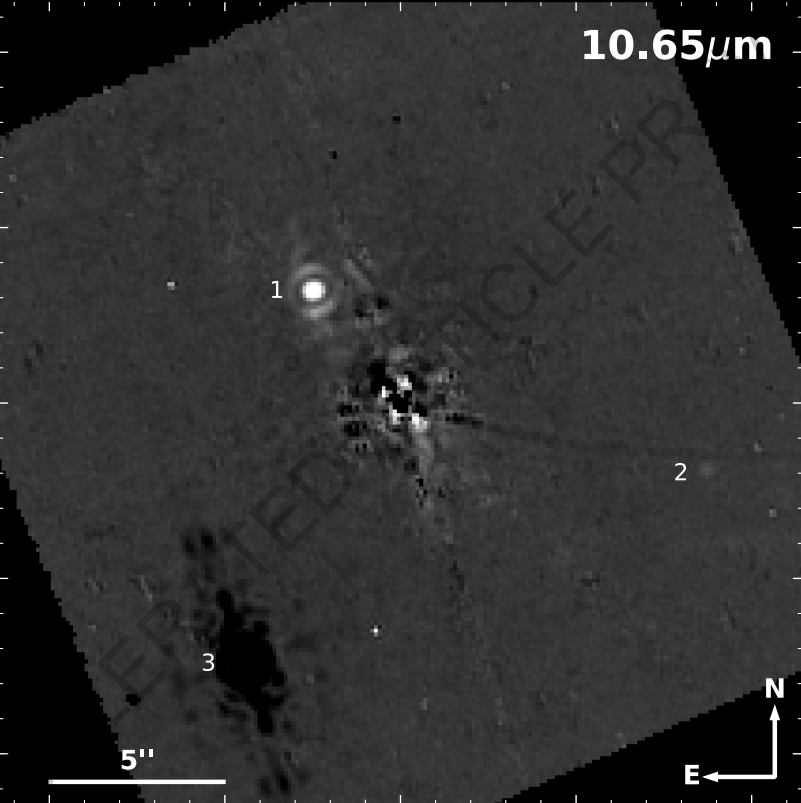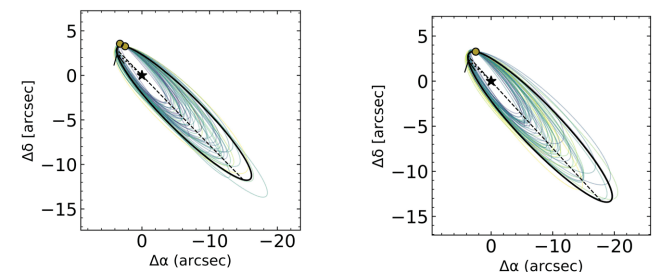The JWST has directly imaged its first exoplanet, a temperate super Jupiter only about 12 light-years away from Earth. It could be the oldest and coldest planet ever detected.
The planet orbits the star Epsilon Indi A (Eps Ind A,) a K-type star about the same age as our Sun. Epsilon Indi is a triple star system, and the other two members are brown dwarfs. The exoplanet is named Epsilon Indi Ab (Eps Ind Ab.)
Eps Ind Ab's detection is presented in a paper published in Nature. Its title is " A temperate super-Jupiter imaged with JWST in the mid-infrared. " The lead author is Elisabeth Matthews, a Postdoc in the Department of Planet and Star Formation at the Max Planck Institute for Astronomy in Germany.
This new detection is important for several reasons. The vast majority of the 5,000+ exoplanets we've discovered were detected by the transit method. Others were detected with the radial velocity method. Comparatively few have been directly imaged as Eps Ind Ab has.
There were already hints that a massive planet orbited Eps Ind A. Previous work using the radial velocity method found the telltale wobble induced in the star by a massive planet orbiting it. Now, the JWST has confirmed the planet's presence.
"Our prior observations of this system have been more indirect measurements of the star, which actually allowed us to see ahead of time that there was likely a giant planet in this system tugging on the star," said team member Caroline Morley of the University of Texas at Austin. "That's why our team chose this system to observe first with Webb."
Direct images of exoplanets are difficult to acquire. The blinding light from the star washes out the relatively dim light that comes from the planet. Telescopes like the JWST use coronagraphs to eliminate the starlight and allow the planetary light to get through. In this case, the space telescope imaged the exoplanet using its Mid-Infrared Instrument (MIRI) Coronagraphic Imaging capability.
The JWST's direct image of Eps Ind Ab revealed some surprises compared to earlier radial velocity measurements.
"While we expected to image a planet in this system because there were radial velocity indications of its presence, the planet we found isn't what we had predicted," shared Matthews. "It's about twice as massive, a little farther from its star, and has a different orbit than we expected. The cause of this discrepancy remains an open question."
Eps Ind Ab is about 6 times more massive than Jupiter, and its semi-major axis is about 28 AU. It's inclined about 103 degrees.
"The atmosphere of the planet also appears to be a little different than the model predictions," Matthews added. "So far, we only have a few photometric measurements of the atmosphere, meaning that it is hard to draw conclusions, but the planet is fainter than expected at shorter wavelengths."
Eps Ind Ab is more similar to Jupiter than any other exoplanet ever imaged, even though it's a little warmer and several times more massive. Other imaged exoplanets tend to be hotter and are still radiating the heat from their formation. Their heat makes them easier to see in infrared. As planets like this age, they tend to contract and cool down. As they get cooler, they can become harder to image directly.
As planets age and cool, the wavelength of their emissions changes, making them harder to see. Most other directly imaged planets are much younger than Eps Ind Ab—all younger than 500 million years. But the JWST is uniquely suited to spotting older exoplanets.
"Cold planets are very faint, and most of their emission is in the mid-infrared," explained Matthews. "Webb is ideally suited to conduct mid-infrared imaging, which is extremely hard to do from the ground. We also needed good spatial resolution to separate the planet and the star in our images, and the large Webb mirror is extremely helpful in this aspect."
Many of the Jupiter-size exoplanets we've discovered are hot Jupiters. These gas giants are easily found using the transit method because they orbit so close to their stars, which makes them hot. They're also usually tidally locked, meaning their daysides can reach extreme temperatures. One hot Jupiter, KELT-9b, has a dayside temperature greater than 7,800 degrees Fahrenheit (4,600 Kelvin), which is hotter than most stars.
But Eps Ind Ab is different. With an approximate temperature of 35 degrees Fahrenheit (2 degrees Celsius), it's one of the coldest exoplanets directly detected. It's the coldest exoplanet ever directly imaged and is only 180 degrees Fahrenheit (100 degrees Celsius) warmer than our Solar System's gas giants. It's more similar to planets in our system and gives astronomers an opportunity to study the atmospheres of Solar System analogs.
The planet's atmosphere doesn't exactly match our expectations. "The atmosphere of the planet also appears to be a little different than the model predictions. So far we only have a few photometric measurements of the atmosphere, meaning that it is hard to draw conclusions, but the planet is fainter than expected at shorter wavelengths," Matthews said.
It could be fainter at those NIR wavelengths because the atmosphere is cloudy. Or it could be because it contains compounds like CH4(methane), CO, and CO2which absorb shorter wavelengths of IR light.
Eps Ind Ab's faintness at those wavelengths hints at a high carbon-to-oxygen ratio. A high C/O ratio is a significant indicator of how the planet formed and evolved. It suggests that the disk the planet formed in was carbon-rich. It's a clue as to where exactly the planet formed and if it migrated.
High carbon also allows more carbon-containing molecules like CH4, CO2and CO to form. Since CO2and methane are greenhouse gases, the high C/O ratio affects the planet's climate.
High C/O ratios also affect cloud formation, which can raise a planet's albedo. A higher albedo reflects more sunlight away from the planet, which also affects climate.
Eps Ind Ab displays high metallicity. High metallicity indicates a higher mass and suggests a more efficient formation process since the planet could've attracted more mass more quickly. It also can affect how the planet may have migrated through the disk.
The researchers wonder whether other cool exoplanets have the same characteristics. But first they need to better constrain these characteristics in Eps Ind Ab. This initial detection and imaging is just the beginning. Future spectroscopy and further imaging will reveal more details about the planet.
The fact that Eps Ind Ab is in a group with two brown dwarfs is also an opportunity for more interesting observations. "The system is also co-moving with a widely separated brown dwarf binary, making it a particularly valuable laboratory for comparative studies of substellar objects with a shared age and formation location," the authors write in their paper. The demarcation line between massive gas giants and brown dwarfs isn't always clear, and astronomers are keen to learn more about how each type forms, especially in the same system as one another.
This research also illustrates the effectiveness of using prior results from other telescopes to choose targets for the JWST. "Even though the detected planet does not match the previously claimed exoplanet properties, long-term RV information provided a clear signpost for the value of imaging this target," the authors explain.
Fortunately, the exoplanet is an excellent candidate for more observations.
They conclude that "the bright flux and wide separation of Eps Ind Ab mean the planet is ideally suited to spectroscopic characterization efforts, allowing the metallicity and carbon-to-oxygen ratio to be more accurately constrained."
 Universe Today
Universe Today



